- Injury challenges defined J.K. Dobbins: Dobbins has faced a rollercoaster of a career marked by significant injuries, notably ACL, LCL, and Achilles tears, yet when healthy, he has demonstrated high-end rushing ability.
- Denver Broncos‘ backfield uncertainty: His 2025 fantasy value hinges on securing a consistent role in a crowded backfield under Sean Payton's system, which historically utilizes multiple running backs.
- Subscribe to PFF+: Get access to player grades, PFF Premium Stats, fantasy football rankings, all of the PFF fantasy draft research tools and more!
Estimated Reading Time: 5 minutes

PFF’s Fantasy Football Player Profile series delivers the most in-depth fantasy football analysis available for the 2025 season.
Using PFF’s exclusive data, we evaluate player performance, competition for touches and how teammates and coaching staffs
Last updated: 7:15 a.m. Sunday, June 22
Player performance
J.K. Dobbins was a second-round pick by the Baltimore Ravens in 2020. He joined a three-man rotation with Gus Edwards and Mark Ingram III. While Ingram was the veteran starter, he was phased out of the offense as the season progressed, which included missing some time due to injury and COVID. Dobbins played less than 50% of Baltimore's offensive snaps over the season but averaged 6.0 yards per carry. From Week 11 to the end of the season, he scored at least one touchdown in each game. He averaged 17.0 fantasy points per game during that stretch, 11th among running backs.
Dobbins suffered an ACL and LCL tear before the 2021 season, causing him to miss the entire year and the first two games of 2022. He played from Weeks 3-6, sharing the backfield with Edwards, but he wasn’t nearly as effective. He was held under 44 rushing yards each week and 3.3 yards per carry or worse in three of four games.
He injured the same knee as last season in Week 6, causing him to miss the following six games. He played from Weeks 14-17, achieving much better results, as he ran the ball 57 times for 397 yards at 7.0 yards per carry. He never played more than 50% of the snaps in any game during the year. Dobbins' injury luck didn’t improve in 2023, as an Achilles tear in Week 1 cost him the entire season.
The Ravens chose to upgrade at running back with Derrick Henry during the 2024 offseason, so both Dobbins and Edwards followed their former offensive coordinator, Greg Roman, to the Los Angeles Chargers. Dobbins was Edwards' backup in Week 1, but he ran 10 times for 135 yards and a touchdown. He started the following week and ran 17 times for 131 yards and another score. While he was the league's fourth-highest scoring fantasy back at that time, he proceeded to gain 3.8 yards per carry or less in five straight games.
He had two games with two touchdowns each in November but then an MCL injury cost him four games. Dobbins returned for the last two games of the season and the playoff loss, but he failed to exceed 4.0 yards per carry in any of those games. Dobbins' ups and downs left him with 14.8 fantasy points per game, the best mark for his career and 18th among running backs on the season.
Dobbins' 69.6 rushing yards per game ranked 10th among running backs last season. While he didn’t have a high rate of 15 or more yard carries, he averaged 0.31 30-yard runs per game, fourth among running backs. His game is still built on long runs, regardless of the situation. While he has plenty of experience playing on passing downs in both his time in Baltimore and Los Angeles, he’s never put up noteworthy receiving numbers.
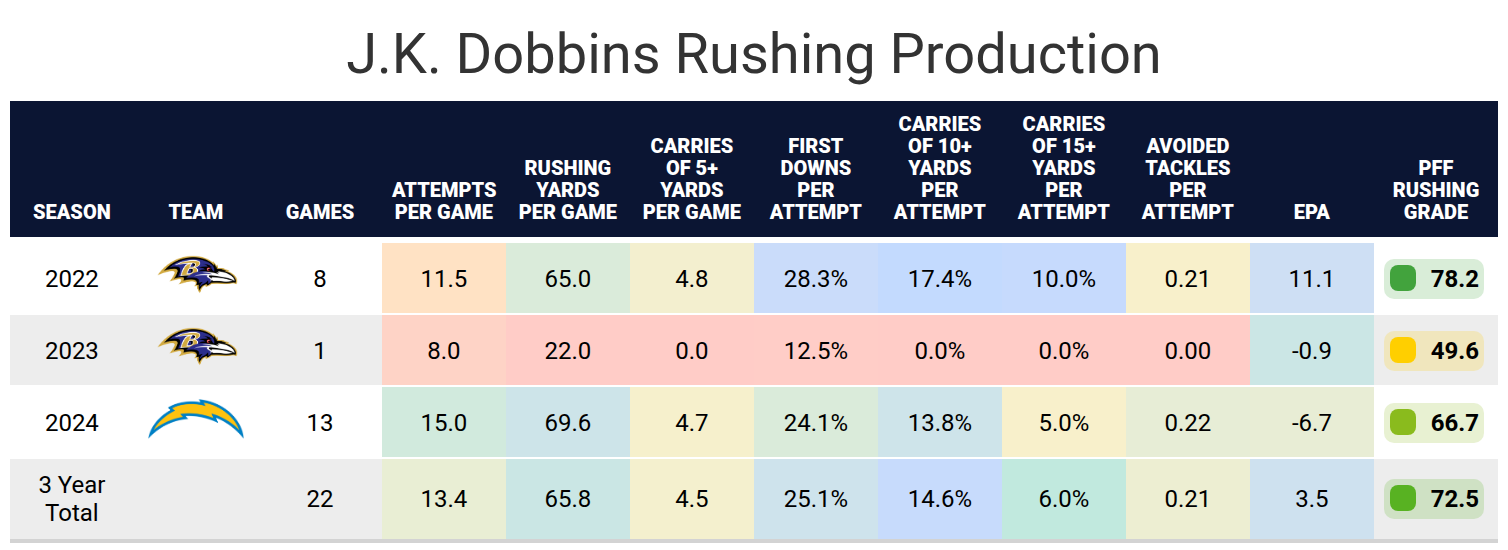
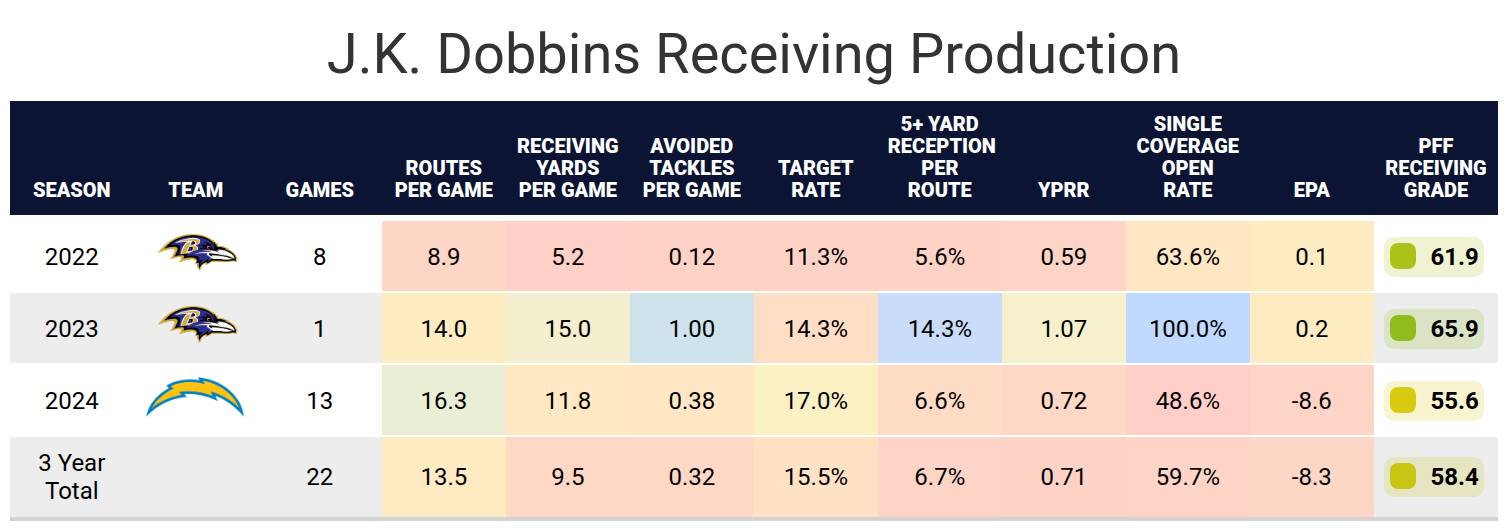
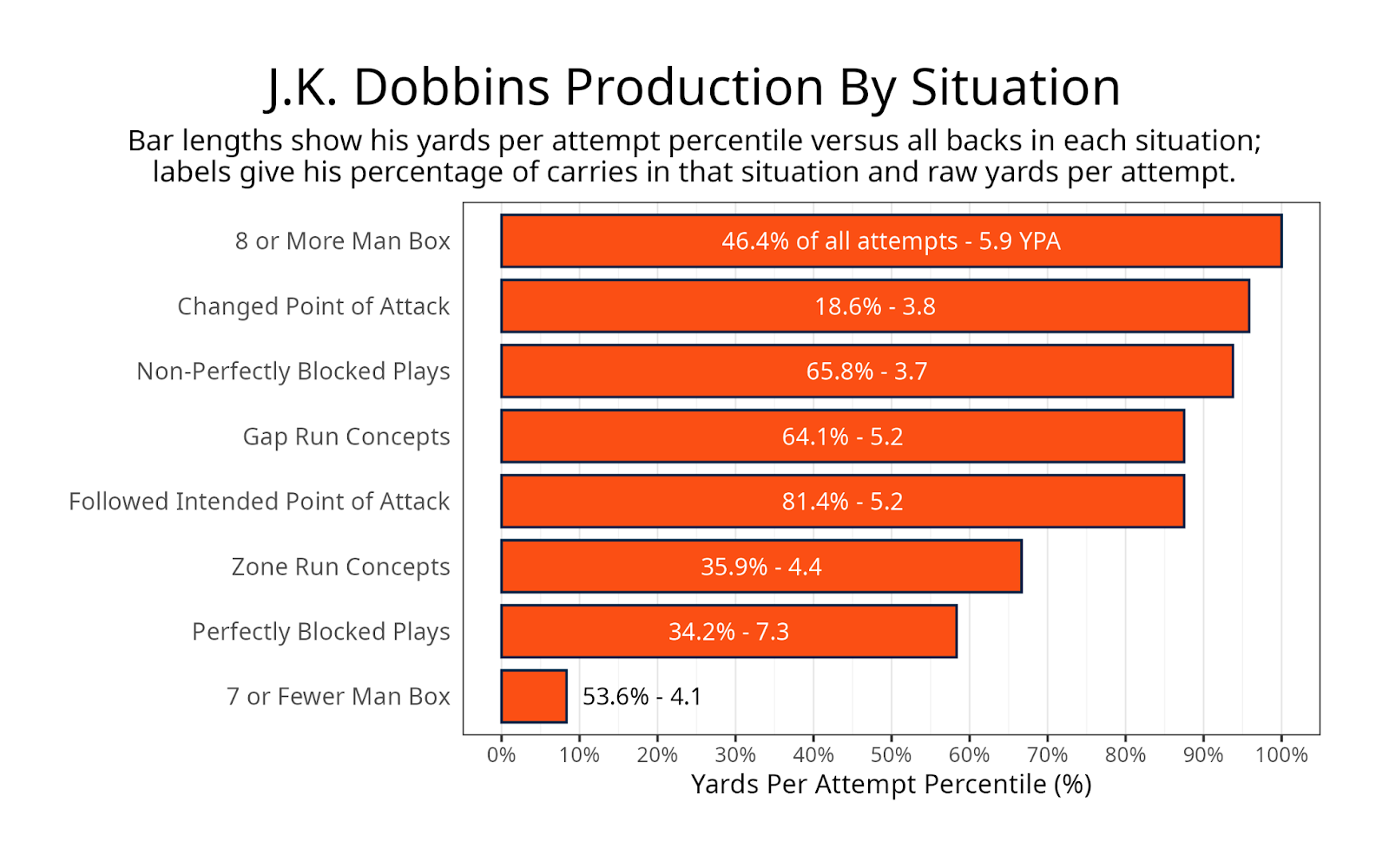
Projected role
Dobbins' role has changed every season of his career. In his rookie season, he was primarily on third downs and two-minute drills, while Edwards was the early-down back. In 2022, Dobbins played more on early downs while Justice Hill played on third downs. With the Los Angeles Chargers, he played a lot in every situation.
The Chargers opted not to re-sign Dobbins or Edwards, instead signing Najee Harris and drafting Omarion Hampton. Dobbins didn’t find a team until over a month after the draft, landing with the Denver Broncos. Denver had a three-man rotation between Javonte Williams, Jaleel McLaughlin and Audric Estime last season. Williams went to the Dallas Cowboys, while the team added R.J. Harvey in the second round of the draft.
Harvey, Dobbins, Estime and McLaughlin may make the roster, although one player would likely be inactive each week, as none of them provide much special-teams value. Dobbins will most likely carve out a role on early downs and could lead the team in carries. However, he could also be lost in an ugly rotation where none of the Broncos' running backs have much success from a fantasy perspective.
While Dobbins is experienced on passing downs, he hasn’t necessarily played well there, and Harvey seems better suited to be the passing-down back. There is a chance Harvey doesn’t play as well as expected or suffers an injury, in which case Dobbins might be the primary backup for passing down snaps.

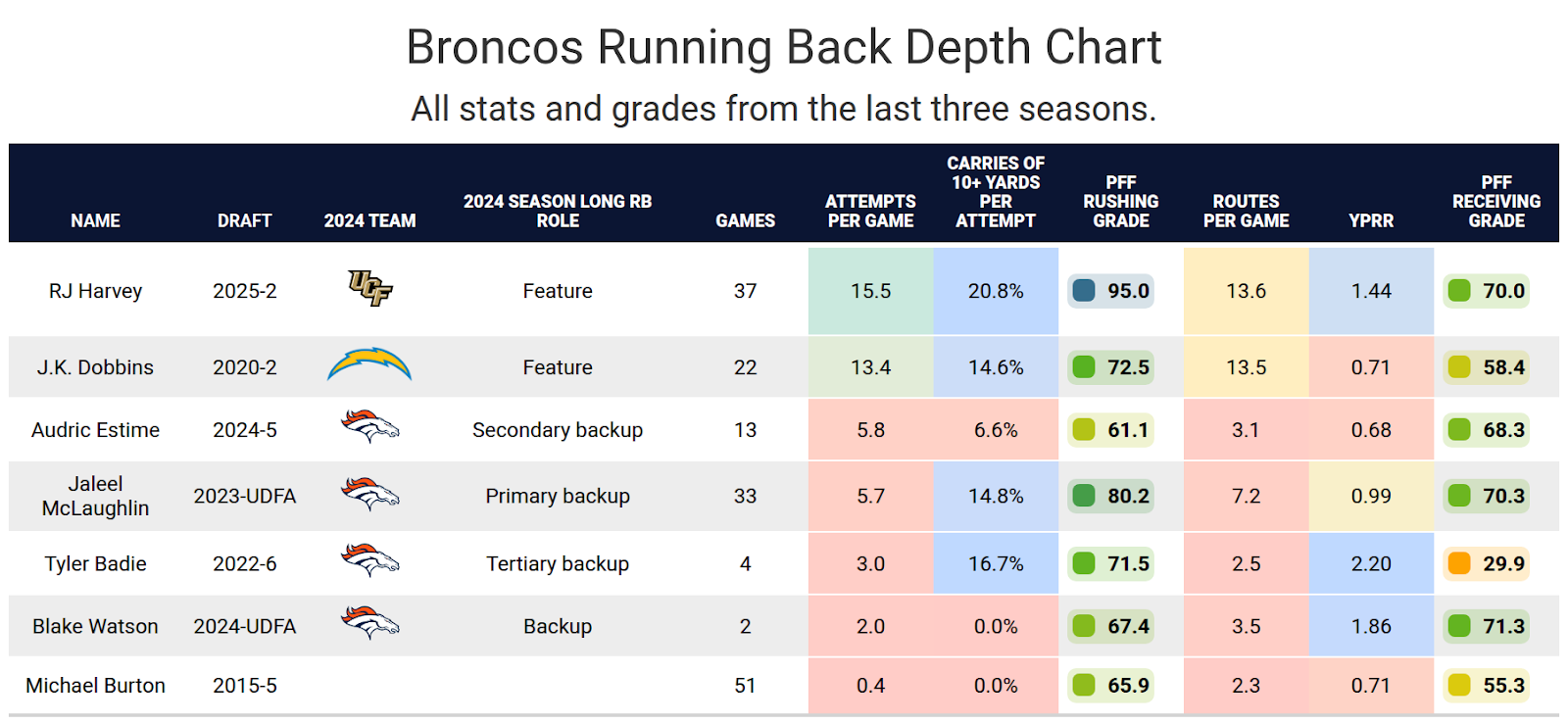
Impact of teammates
Dobbins joins Sean Payton, a coach who is used to both highly successful fantasy backs and committees in the backfield. The big question is if the Broncos will have a three-man backfield or if it can condense to a two-man backfield.
From 2008-2016, Payton’s New Orleans Saints consistently had three running backs with at least 200 offensive snaps but typically had no one exceed 500 snaps. They would have one bigger back like Deuce McAllister, Mike Bell, Ladell Betts or Mark Ingram II, and two smaller backs with some combination of Reggie Bush, Pierre Thomas, Darren Sproles or Travaris Cadet. In his last few seasons with the Saints, it was typically Ingram or Latavius Murray as an early-down back and Alvin Kamara as the receiving back.
There is a chance the backfield resembles the earlier Saints teams, where Estime takes an early-down role, Dobbins fills the Thomas role of doing everything, and Harvey takes the Bush/Sproles role. This would make it hard to trust anyone in fantasy. However, there is also a chance Dobbins takes the Ingram role, which would be fitting considering they were former teammates, and Harvey takes the Kamara role. In the first two years of Ingram and Kamara, both running backs were top-30 fantasy running backs in both seasons.
The Broncos' offensive line is generally more of an asset than a liability. The line stayed very healthy last season, as all five starters played at least 850 snaps and at least 14 of 18 games, including the playoffs. Denver retained all five linemen for this season. Lines generally play better the more snaps they play together. However, all five players are also at a point in their careers where you wouldn’t expect much more improvement.

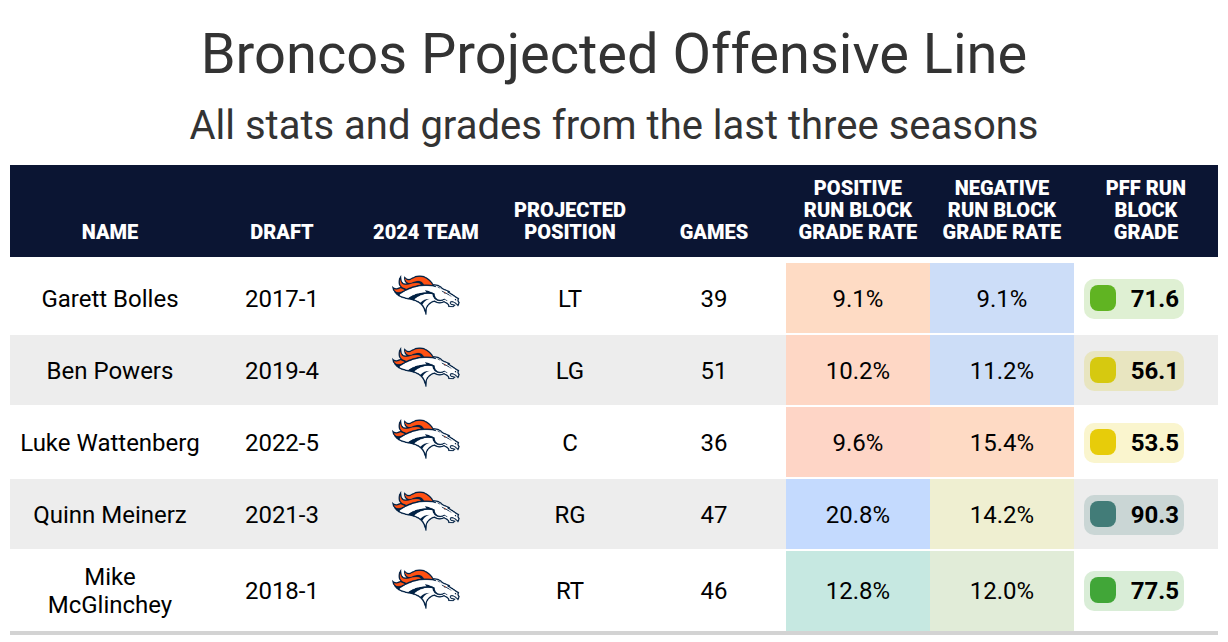
Bottom line
There is a very wide range of outcomes for J.K. Dobbins this season. Not many have him as a top-12 option, but there are plenty of scenarios where he finishes as a top-24 fantasy running back in points per game, even though it might be impossible to know which weeks he will do well and which weeks he won’t.

Footnotes
- Statistics in tables and charts were chosen based on their ability to predict future fantasy performance on a per-game or per-opportunity basis or to describe the player relative to others at the same position.
- “Opportunities” are defined as passing dropbacks, rushing attempts and routes run as a receiver.
- Numbers are provided either by season or based on the past three years. For rookies, only college statistics are included. For non-rookies, only NFL statistics are considered, regardless of whether they played in college within the previous three years.
- As college competition is easier than NFL competition, most rookies are likely to see a decline from their historical numbers.
- Only FBS data is considered for college players and comparisons.
- Kneel-downs are removed from rushing data to provide cleaner quarterback rushing rate statistics.
- The table colors in this article range from blue (indicating good/high) to red (indicating bad/low).
- All percentiles and color codings compare the given player to others with a high sample of opportunities. Generally, the cutoff is one-third of the possible opportunities in the sample. If a player does not meet the threshold, they are still included in the comparison, though their results may appear better or worse than expected due to the smaller, less predictive sample size.
- Information on utilization classifications and their importance can be found here for running backs, wide receivers and tight ends.



 © 2025 PFF - all rights reserved.
© 2025 PFF - all rights reserved.